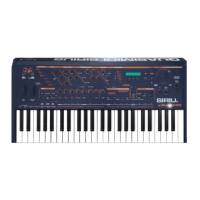Important:
Tip:
The Gain-control on the back of the Sirius determines also the input sensitivity of the
ANALYSE-IN. If you connect other audio equipment to this socket you should first set the Gain-
control to minimum.
You can switch the external Carrier-signal on and off with the CARRIER-EXT.key on the MIXER-panel.
The external Analyse-signal is controlled with exactly the same key as the microphone-signal. This
means the MICRO.-key on the MIXER-panel also switches the external Analyse-signal on and off.
By the way - the Sirius-Vocoder allows you to mix internal Parts, microphone signals and external au-
dio sources almost randomly - this is for the Analyse-signal as well as the Carrier-signal. One excep-
tion: If you have connected an audio cable to the ANALYSE-IN-socket, the MICROPHONE CON-
NECTOR on the front panel will be disabled.
Would you like to use your own favorite microphone? Instead of the Goose-neck microphone in-
cluded with your Sirius, you can connect other dynamic microphones directly into the MICRO-
PHONE CONNECTOR-socket (XLR-socket) of the Sirius. The ANALYSE-IN is also suitable to connect
a microphone. If you want to use a condenser-microphone you will need an external phantom-
power supply. Whatever Microphone you choose to use, make sure the Gain-control is sensibly ad-
justed to avoid feedback.
You can use the change of volume of single Vocoder-tracks to create some interesting effects because
you can emphasize or de-emphasize each of the 11 frequency Bandwidth (Vocoder 'Bands') which
make up your complete vocoded sound. Even more interesting is performing these changes in real-
time while the sequencer section is active. You can create, for example, real-time morphing of Pads
or sound atmospheres. These options are made available to you using the dials of the MIXER-panel:
here you can, while your sequencer is running, set the volumes for the single Vocoder-Bands. On the
dials you have Vocoder-Bands 2-9 which each represent one bandwidth, from the deepest bass to
the highest treble. Band-2 is the deepest bass, Band 9 the highest treble. (the other Bands are con-
trollable only in the Edit-Vocoder menu - see page 91).
To set the Band-volume hold down the Vocoder-key and turn the control in the MIXER-panel at the
same time. The photo on the next page will make it clear to you.
Changing the level of the individual Vocoder tracks:
The Vocoder
87
CARRIER-IN ANALYSE-IN GAIN
Gain-Control
Increasing the
input-sensitivity
Set the Gain-Control to minimum first.
To increase the level carefully turn it
to the left.
SNARE HIHAT PERCUSSION SYNTH 1 SYNTH 2 SYNTH 3 VOCODERKICK/BD
BAND 2
Frequency increased
BAND 3 BAND 4 BAND 5 BAND 6 BAND 7 BAND 8 BAND 9
The settings for the
CARRIER.EXT.- and
the MICRO-.keys
can be stored in a
SONG.
You can store the
Band-volume
settings in a SONG.
!
Tip
T

